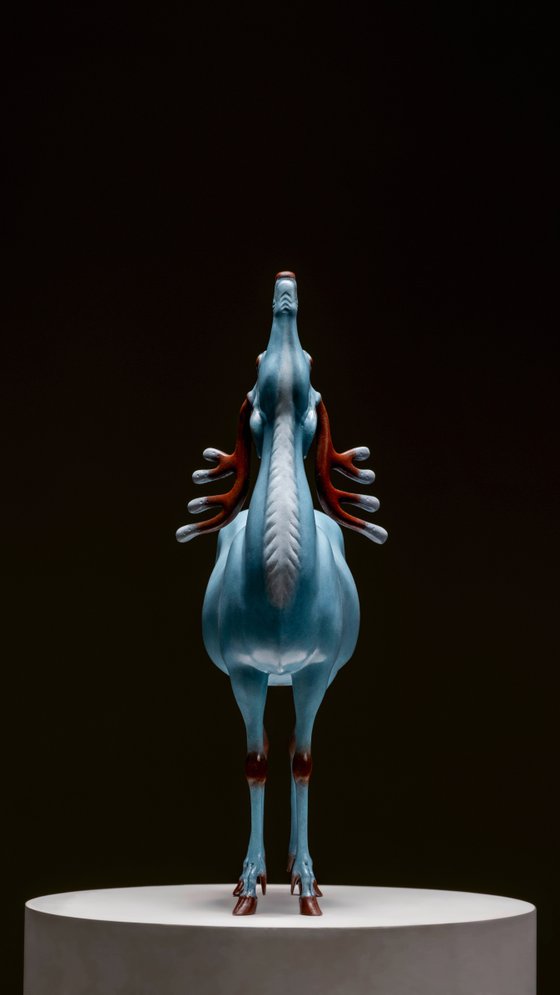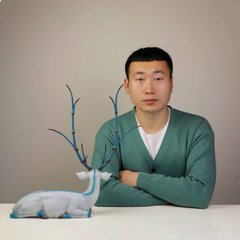- By medium
- By subject
- By budget
- Sales
- Gift cards
- Discover all art
- Artists
- Editors’ picks
- Ideas
Artwork description:
⭕The shipping cost includes customs duties, so you don't need to worry about additional fees.(Including US shipments)
The moon, this resplendent pearl in the night sky, carries profound significance in different cultures.
In Chinese culture, looking up at the moon is an ancient and profound experience. The moon symbolizes reunion. Whenever people look up at that round moon, a surge of longing for family and nostalgia for hometown wells up in their hearts. It also represents loftiness and tranquility. Just as poets express their insights into life and pursuit of an ideal realm under the moon. From the boldness of "When will the moon be clear and bright? With a cup of wine in my hand, I ask the blue sky." to the warmth of "A bright moon rises above the sea, even though we're far apart, we share this moment.", the moon has witnessed the joys and sorrows of the Chinese people and has become an important symbol of national emotion and culture.
In the Western literary classic "The Moon and Sixpence", the moon is endowed with the symbolic meaning of an ideal. The protagonist bravely pursues the moon in his heart, gives up his comfortable life and embarks on an art path full of challenges. This persistent pursuit of ideals shows the deep-seated desire for self-realization in the human heart.
This work takes looking up at the moon as its theme, aiming to fuse different understandings of the moon in Chinese and Western cultures and convey a universal emotion that transcends cultures. The work uses the image of a clear deer looking up at the moonlit sky to create a serene and mysterious atmosphere. Whether it is the Chinese people's longing for family and harmony or the Westerners' brave pursuit of ideals, they can all find resonance in this moment of looking up at the moon.
I hope that the audience can stop their hurried steps, look up at that round moon, and think about the meaning and value of life. In this era of globalization, let us cross cultural boundaries, jointly feel the spiritual touch brought by the moon, cherish those beautiful emotions and pursuits, and inject more poetry and warmth into our lives.
Materials used:
bronze
Waiting for the Moon (2022) Bronze sculpture
by Zhang Youzhi 张有志
£1,571.12
- Bronze sculpture on Other
- From a limited edition of 99
- Size: 21 x 39 x 14cm
- Signed and numbered certificate of authenticity
- Style: Expressive and gestural
- Subject: Animals and birds
Loading
Artwork description
⭕The shipping cost includes customs duties, so you don't need to worry about additional fees.(Including US shipments)
The moon, this resplendent pearl in the night sky, carries profound significance in different cultures.
In Chinese culture, looking up at the moon is an ancient and profound experience. The moon symbolizes reunion. Whenever people look up at that round moon, a surge of longing for family and nostalgia for hometown wells up in their hearts. It also represents loftiness and tranquility. Just as poets express their insights into life and pursuit of an ideal realm under the moon. From the boldness of "When will the moon be clear and bright? With a cup of wine in my hand, I ask the blue sky." to the warmth of "A bright moon rises above the sea, even though we're far apart, we share this moment.", the moon has witnessed the joys and sorrows of the Chinese people and has become an important symbol of national emotion and culture.
In the Western literary classic "The Moon and Sixpence", the moon is endowed with the symbolic meaning of an ideal. The protagonist bravely pursues the moon in his heart, gives up his comfortable life and embarks on an art path full of challenges. This persistent pursuit of ideals shows the deep-seated desire for self-realization in the human heart.
This work takes looking up at the moon as its theme, aiming to fuse different understandings of the moon in Chinese and Western cultures and convey a universal emotion that transcends cultures. The work uses the image of a clear deer looking up at the moonlit sky to create a serene and mysterious atmosphere. Whether it is the Chinese people's longing for family and harmony or the Westerners' brave pursuit of ideals, they can all find resonance in this moment of looking up at the moon.
I hope that the audience can stop their hurried steps, look up at that round moon, and think about the meaning and value of life. In this era of globalization, let us cross cultural boundaries, jointly feel the spiritual touch brought by the moon, cherish those beautiful emotions and pursuits, and inject more poetry and warmth into our lives.
Materials used:
bronze
14 day money back guaranteeLearn more






